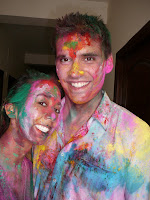Jaisalmer’s Old Town, like Venice or Bath, gives the tourist the impression of having stepped into an impressive and gigantic museum diorama. Nearly 1000 years ago, this city—set along the cusp of the Thar Desert—was an important stop along camel trading routes between the Subcontinent and Central Asia. Its distance from Delhi (and its formidable hilltop fort) helped preserve it from military incursions during the Mughal era. Today, Jaisalmer is known as the Golden City—sun-kissed and steamy, raked by desert winds, and caught in a Medieval time warp.
The city’s nickname is apt: Jaisalmer retains a golden hue, the color of perfectly baked crème brulee. This is due to the yellowish sandstone used to build much of the Old Town’s buildings, coupled with the ever-present sunlight that burns down on the city. The foreboding fort stands atop Trikuta Hill, outlined by 99 circular bastions (some of which have been converted into balconies for a boutique hotel). Jaisalmer Fort is unique for Rajasthani forts in that people still live and work inside its walls. Therefore, tourists passing through the fort see school children walking to class along the fort’s narrow stone lanes, observe women hanging laundry from crumbling rooftop eaves, and get hassled by vendors and rickshaw touts who own shops in the shadow of the maharjah’s palace.
Jenna and I spent a day walking around Jaisalmer’s Old Town and taking an audio tour of the palace. Marching to the top of the palace’s battlements, we could easily understand why Jaisalmer likes to brag that its fort was never captured (though most Rajasthani towns make the same claim about their own forts). Jaisalmer sits on a precipitous rise that would have given ancient lookouts unobstructed views across the desert plains, east and north towards Delhi and west towards Persia. Advancing armies could not have ambushed Jaisalmer. The audio tour told us as we stood on the palace’s highest point, “On a clear day, you can see all the way to Pakistan.” Jaisalmer Fort was about as close as I wanted to get, at the moment.
The circuitous lanes around the fort have an inconvenient asymmetry, typical of towns built hundreds of years ago. It is easy to get lost in the tributaries and criss-crossing interstices of these streets. It is equally as easy to step in cow dung, too. Rajasthan is a proudly Hindu state, and cows are a common sight on roads, sidewalks, and highways. Jaisalmer’s cloistered nature makes the cows appear extra large and more numerous than normal. Their droppings dot the streets like digital pins on a GPS display. No coincidence, then, that Jaisalmer smells like you would imagine it smelled like 1000 years ago.
Open sewage is actually a pressing problem in Jaislamer. The fort and Old Town, as originally conceived, was not built to handle the amount of waste that is now produced in its environs. UNESCO reports that the fort is actually sinking on its foundations as its pipes and sewers decay from overuse and lack of maintenance. Open drains line the streets of the Old Town and liquid black sludge gurgles by unappealingly.
It appears as if I am not being kind to Jaisalmer, but we actually enjoyed it immensely. The atmosphere was clear and the air (once you got away from the open sewers) was cleaner than Delhi or Calcutta. Once the sun set, the temperature dropped to a pleasantly mild level that made eating on our hotel’s rooftop terrace enjoyable.
Jaisalmer, at night, makes you feel like the ancient traditions and customs of this region have a direct link to the past. The call to prayer from local mosques, the rhythmic chanting from a Sikh temple, the bells clanging from a Hindu shrine, the nasally whine of a satara flute, the clack of hooves on cobblestone—these sounds waft up to a listener as he surveys the glowing lights of Jaisalmer, surrounded comfortably in a soft blanket of desert darkness. For a moment, he has convinced himself it is 1155, and Jaislamer is brand new.

 Citizens of Jaisalmer's Old Town, attired in typical Rajasthani fashion. Elaborate (and painful-looking) nose rings are common for women in this region, as are the startlingly bright fabrics that contrast with the dun-colored desert. These women were selling anklets and jewelry outside the fort.
Citizens of Jaisalmer's Old Town, attired in typical Rajasthani fashion. Elaborate (and painful-looking) nose rings are common for women in this region, as are the startlingly bright fabrics that contrast with the dun-colored desert. These women were selling anklets and jewelry outside the fort.  A view of Jaisalmer's Old Town from the uppermost battlement of the City Palace. The twin spires in the center are from a nearby Jain temple. Pakistan looms somewhere on the horizon.
A view of Jaisalmer's Old Town from the uppermost battlement of the City Palace. The twin spires in the center are from a nearby Jain temple. Pakistan looms somewhere on the horizon.  Among the biggest surprises of old Jaisalmer was an Australian-owned restaurant with remarkably authentic apple pie, made from organic ingredients and served with homemade ice cream.
Among the biggest surprises of old Jaisalmer was an Australian-owned restaurant with remarkably authentic apple pie, made from organic ingredients and served with homemade ice cream. 








































